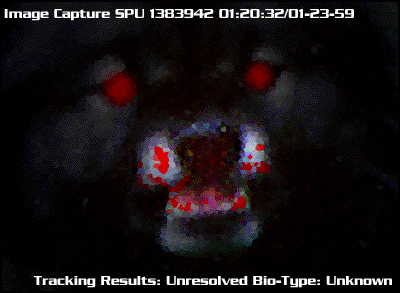|

Official Interdepartmental Memo
To: Max Anders, Project CritterTech Supervisor
Re: Rex, Spot, and Muffy
From: Danielle Sterling, Facility BioMatrix1 Lab Director
Date: 02/12/57
Mr. Anders,
Let me start by taking back all the nasty things I’ve ever said in regards
to this project idea, including the ones I simply uttered in my mind which
were ten times nastier than anything I’ve ever said to your face. To sum
it all up: Rex, Spot, and Muffy are doing fine.
The following is a summary of our progress:
To begin, the main problem we ran into is the fact that a dog isn’t
spectacularly adept at using a cyberdeck. We fixed up a primitive one with
just a couple of keys (pedals, really) and while Spot could hit a couple
of them when necessary, Muffy would mostly try to lick the electronics
and Rex couldn’t be around the thing for more than five minutes without
trying to take a leak on it. None of them could deal with the simultaneous
presence in both the real and matrix worlds without getting confused. It
was clear that we’d have to figure out a way to go purely cybernetic, a
prospect we didn’t especially care for because even a human doesn’t last
long naked in the matrix and we figured a dog wouldn’t stand a chance.
This, of course, only left us with the option of installing a head deck
which, as you know from the demise of the SmartDog project, would never
work because their brains simply aren’t large enough to hold all the necessary
gear. Through all of this we also had to keep in mind the high intolerance
all animals have towards cyberware. The last thing we wanted was a pack
of Cujos tromping around our lab.
It was Sammy, an intern, who hit upon the idea of what he called an
“Instinctual Construct Filter”. He theorized, correctly as it seems, that
the reason why many animals cannot deal with influxes of cyberware and
alternate realities such as the matrix is because they directly contradict
the natural, reality based perceptions of the animal’s instincts. In other
words, they can’t take it because they can’t understand it. Even the smartest
dog is still 80 percent reality based instinct, and you cannot simply train
all if this instinct away. So, in short, we stopped trying to make the
dog like the matrix and concentrated on making the matrix like the dog.
The filter itself is much like a simsense deck, translating the normal
visual constructs of the matrix into, well, “dog based” images. The images
portrayed vary depending on the breed. Rex, the Lab, has a filter which
reflects the matrix world as a playground filled with children. Spot, the
Doberman, has a junkyard filter. Muffy’s looks like a nice, upper class
home. The dogs roam, play, and go about their daily business almost entirely
in the matrix. They still have a bit of a problem popping back into the
real world but we quickly remedied this problem by sedating them before
jacking them out.
Ok, this is all nice and fun, we have a group of dogs who are good with
children, but where do the matrix security aspects come into this? How
do you train a dog to launch an attack program against an intruder? As
it turns out, it’s not that difficult. At least not theory wise. Programming
everything was a bitch.
When an animal engages in an instinctual act its thoughts focus on
a specific goal, be it to kill, run, evade, etc. It’s almost as if the
animal already has a set of “programs” in its brain. Contained within each
of these “programs” is a subset of “functions” which allow the program
to execute. Using “kill” as an example, the subset is a series of quick
calculations and recalculations designed to bring about the final instinctual
goal of killing. The animal tries an attack and, if it does not work, switches
immediately to another approach, continuing until the instinct is followed
through with and the target of the instinctual aggression is dead. It is
identical to the way a decker tests for weaknesses in a target construct
or persona with the ultimate goal of crashing it.
After several months of programming, we came up with a subunit to the
Instinctual Construct Filter which translated a target’s actions into something
the dogs would be able to understand and use their instincts against. This
filter also translates the dogs’ instinctual reactions into something the
computer will understand. The translation right now is a bit slow, but
our next generation ICF should improve speed tenfold.
The only thing left to do was to convince the dogs that a specific target
was, indeed, the enemy. This was probably this easiest part of the whole
project. All you had to do was introduce a man in black into Rex’s playground,
a thief into Spot’s junkyard, or virtually anything into Muffy’s mansion.
Currently the dogs are only adept at the use of Attack like procedures
and cannot leave our corporation’s section of the matrix due to the disastrous
consequences of any disruption of the ICF. Until we find a sure fire way
to override the reality filters of other systems, Rex, Spot, and Muffy
are pretty much stuck in the dog house.
Sincerely,
Danielle Sterling
p.s. We’re out of Kibbles N’ Bits.
|